Introduction
The results reported in the January 2020 bank lending survey (BLS) relate to changes observed during the fourth quarter of 2019 and expectations for the first quarter of 2020. The survey was conducted between 6 and 27 December 2019. The response rate was 100%. In addition to results for the euro area as a whole, this report also contains results for the four largest euro area countries.[1]
A number of ad hoc questions were included in the January 2020 survey. They look at the impact that the situation in financial markets has had on banks’ access to retail and wholesale funding, the impact of ongoing regulatory or supervisory changes on banks’ lending policies, the impact of banks’ non-performing loan (NPL) ratios on lending policies, and the impact of the ECB’s third series of targeted longer‑term refinancing operations (TLTRO-III).
1 Overview of results
Credit standards (i.e. banks’ internal guidelines or loan approval criteria) for loans to enterprises and loans to households for house purchase remained broadly unchanged in the fourth quarter of 2019. For loans to enterprises, this was in spite of a continued tightening impact stemming from risk perceptions relating to the economic outlook. Meanwhile, credit standards for consumer credit continued to tighten. Demand for loans to enterprises declined for the first time since the fourth quarter of 2013, reflecting the slowdown in economic activity that has been observed since 2018. In contrast, demand for housing loans and consumer credit continued to increase.
Credit standards for loans to enterprises and housing loans remained broadly unchanged in the fourth quarter of 2019 (with the net percentage of banks reporting tightening standing at 1% for both types of lending, compared with -2% in the third quarter of 2019; see overview table), in line with expectations expressed in the previous survey round. Credit standards for consumer credit and other lending to households continued to tighten (net percentage of 3%, unchanged from the previous quarter), despite banks expecting them to remain broadly unchanged. Looking ahead to the first quarter of 2020, banks expect credit standards for loans to enterprises to remain unchanged, while they expect credit standards to tighten for housing loans (3%) and to ease for consumer credit and other credit to households (‑6%).
Banks’ risk perceptions (owing to both the general economic situation and the firm‑specific situation) continued to have a tightening impact on credit standards for loans to enterprises. In contrast, for loans to households for house purchase, risk perceptions had an easing impact, owing to still favourable housing market prospects and borrowers’ creditworthiness. For both loans to enterprises and housing loans, competition (mainly from other banks) had an easing impact, while banks’ risk tolerance, funding costs and balance sheet constraints had a broadly neutral impact overall. For consumer credit and other lending to households, all contributing factors had a broadly neutral impact overall.
For new loans to enterprises, banks’ overall credit terms and conditions (i.e. the actual terms and conditions agreed in loan contracts) remained unchanged. While margins on average loans to enterprises (defined as the spread over relevant market reference rates) narrowed, they continued to widen for riskier loans. There was also an increase in non-interest rate charges. Banks’ overall terms and conditions also remained broadly unchanged for housing loans, as margins on average loans declined and margins on riskier loans increased slightly. In addition, loan-to-value ratios had a tightening impact. Terms and conditions for consumer credit eased, driven by narrower margins on average loans, while margins increased slightly for riskier loans.
The net percentage of banks reporting an increase in rejection rates for loan applications rose across all loan categories, particularly for loans to enterprises.
Net demand for loans to enterprises declined in the fourth quarter of 2019 (with a net percentage of -8%, down from 1% in the third quarter of 2019), the first time this had been seen since the fourth quarter of 2013, whereas banks had expected it to remain stable overall. That decline in net demand was broadly based across a number of larger and smaller euro area countries. Banks expect that demand will continue to decline in the first quarter of 2020 (net percentage of -9%). In contrast, there was a pronounced increase in net demand for housing loans (net percentage of 25%, up from 15%), as well as an increase in net demand for consumer credit (net percentage of 10%, up from 8%). For the first quarter of 2020, banks expect to see increases in net demand for both housing loans (6%) and consumer credit (15%).
Demand for loans to enterprises continued to be supported by the low general level of interest rates and, to a lesser extent, M&A activities. The positive contribution made by the low general level of interest rates increased relative to previous survey rounds. In contrast, financing needs for fixed investment ceased to contribute positively to firms’ loan demand. In fact, in most countries where banks indicated a decline in net demand, fixed investment contributed to that decline, in line with subdued economic activity. Net demand for housing loans continued to be driven by the low general level of interest rates and favourable housing market prospects, while consumer confidence and debt refinancing contributed more positively than in previous quarters. For consumer credit and other lending to households, the low general level of interest rates, consumer confidence and spending on durable goods all contributed positively to loan demand.
Looking at the four largest euro area countries, credit standards for loans to enterprises tightened in Spain and France in the fourth quarter of 2019, while they remained unchanged in Germany and Italy (see overview table). For housing loans, credit standards tightened in Spain and France, eased in Italy and remained unchanged in Germany. Net demand for loans to enterprises declined in Spain and, to a lesser extent, France, while net demand increased in Germany and remained unchanged in Italy. Net demand for housing loans increased in France, Germany and Italy, but fell in Spain.
Overview table
Latest BLS results for the largest euro area countries
(net percentages of banks reporting a tightening of credit standards or an increase in loan demand)

Notes: The “Avg.” columns contain historical averages, which are calculated over the period since the beginning of the survey, excluding the most recent round. For France, net percentages are weighted on the basis of outstanding loan amounts for individual banks in the respective national samples.
The January 2020 BLS also included a number of ad hoc questions. As regards euro area banks’ access to wholesale and retail funding, banks reported (in net terms) that access to debt securities funding and securitisation continued to improve in the fourth quarter of 2019, while their access to money markets and retail funding remained broadly unchanged.
Euro area banks reported a continued strengthening of their capital positions against the backdrop of regulatory and supervisory actions in the second half of 2019. At euro area level, banks reported a tightening impact on credit standards across all loan categories, with further tightening expected over the next six months.
Euro area banks reported that NPL ratios had a small tightening impact on credit standards for loans to enterprises and consumer credit in the second half of 2019, as well as a broadly neutral impact on credit standards for housing loans. Over the next six months, they expect that tightening impact to increase somewhat for loans to enterprises and consumer credit. According to banks, that tightening impact of NPL ratios came about primarily via reduced risk tolerance and via risk perceptions relating to the general economic outlook and borrowers’ creditworthiness.
On the impact of the TLTRO-III series, banks indicated that they used TLTRO-III liquidity largely for granting loans to the non-financial private sector and replacing TLTRO-II funds. Euro area banks plan to increase their TLTRO-III participation in the future. Given the attractive conditions surrounding TLTRO-III operations, the profitability motive has been the most important reason for banks to participate so far. As regards their lending policies, banks indicated that the TLTRO‑III series had an easing impact on their terms and conditions, with a smaller easing impact on credit standards and a positive net impact on lending volumes.
Box 1
General notes
The bank lending survey (BLS) is addressed to senior loan officers at a representative sample of euro area banks. In the current survey round, 144 banks participated in the survey, representing all euro area countries and reflecting the characteristics of their respective national banking structures. The main purpose of the BLS is to enhance the Eurosystem’s knowledge of bank lending conditions in the euro area.[2]
BLS questionnaire
The BLS questionnaire contains 22 standard questions on past and expected future developments: 18 backward-looking questions and four forward-looking questions. In addition, it contains one open-ended question. Those questions focus on developments in loans to euro area residents (i.e. domestic and euro area cross-border loans) and distinguish between three loan categories: loans or credit lines to enterprises; loans to households for house purchase; and consumer credit and other lending to households. For all three categories, questions are asked about the credit standards applied to the approval of loans, the terms and conditions of new loans, loan demand, the factors affecting loan supply and demand conditions, and the percentage of loan applications that are rejected. Survey questions are generally phrased in terms of changes over the past three months or expected changes over the next three months. Survey participants are asked to indicate in a qualitative way the strength of any tightening or easing or the strength of any decrease or increase, reporting changes using the following five-point scale: (1) tightened/decreased considerably, (2) tightened/decreased somewhat, (3) basically no change, (4) eased/increased somewhat or (5) eased/increased considerably.
In addition to the standard questions, the BLS questionnaire may contain ad hoc questions on specific topics of interest. Whereas the standard questions cover a three-month time period, the ad hoc questions tend to refer to changes over a longer time period (e.g. over the past and next six months).
Aggregation of banks’ replies to national and euro area BLS results
The responses of the individual banks participating in the BLS are aggregated in two steps. In the first step, the responses of individual banks are aggregated to form national results for euro area countries. And in the second step, those national BLS results are aggregated to form euro area BLS results.
In the first step, banks’ replies can be aggregated to form national BLS results by applying equal weights to all banks in the sample[3] or, alternatively, by applying a weighting scheme based on outstanding loans to non-financial corporations and households for the individual banks in the respective national samples. Specifically, for France, Malta, the Netherlands and Slovakia, an explicit weighting scheme is applied.
In the second step, since the numbers of banks in the national samples differ considerably and do not always reflect those countries’ respective shares of lending to euro area non-financial corporations and households, the national survey results are aggregated to form euro area BLS results by applying a weighting scheme based on national shares of outstanding loans to euro area non-financial corporations and households.
BLS indicators
Responses to questions relating to credit standards are analysed in this report by looking at the difference (the “net percentage”) between the percentage of banks reporting that credit standards applied in the approval of loans have been tightened and the percentage of banks reporting that they have been eased. For all questions, the net percentage is determined on the basis of all participating banks that have business in or exposure to the respective loan categories (i.e. they are all included in the denominator when calculating the net percentage). This means that banks that specialise in certain loan categories (e.g. banks that only grant loans to enterprises) are only included in the aggregation for those categories. All other participating banks are included in the aggregation of all questions, even if a bank replies that a question is “not applicable” (“NA”). This harmonised aggregation method was introduced by the Eurosystem in the April 2018 BLS. It has been applied to all euro area and national BLS results in the current BLS questionnaire, including backdata.[4] The resulting revisions for the standard BLS questions have generally been small, but revisions for some ad hoc questions have been larger owing to a higher number of “not applicable” replies by banks.
A positive net percentage indicates that a larger proportion of banks have tightened credit standards (“net tightening”), whereas a negative net percentage indicates that a larger proportion of banks have eased credit standards (“net easing”).
Likewise, the term “net demand” refers to the difference between the percentage of banks reporting an increase in loan demand (i.e. an increase in bank loan financing needs) and the percentage of banks reporting a decline. Net demand will therefore be positive if a larger proportion of banks have reported an increase in loan demand, whereas negative net demand indicates that a larger proportion of banks have reported a decline in loan demand.
In the assessment of survey balances for the euro area, net percentages between -1 and +1 are generally referred to as “broadly unchanged”. For country results, net percentage changes are reported in a factual manner, as differing sample sizes across countries mean that the answers of individual banks have differing impacts on the magnitude of net percentage changes.
In addition to the “net percentage” indicator, the ECB also publishes an alternative measure of banks’ responses to questions relating to changes in credit standards and net demand. This measure is the weighted difference (“diffusion index”) between the percentage of banks reporting that credit standards have been tightened and the percentage of banks reporting that they have been eased. Likewise, as regards demand for loans, the diffusion index refers to the weighted difference between the percentage of banks reporting an increase in loan demand and the percentage of banks reporting a decline. The diffusion index is constructed in the following way: lenders who have answered “considerably” are given a weight (score of 1) which is twice as large as that given to lenders who have answered “somewhat” (score of 0.5). The interpretation of the diffusion indices follows the same logic as the interpretation of net percentages.
Detailed tables and charts based on the responses provided can be found in Annex 1 for the standard questions and Annex 2 for the ad hoc questions. In addition, BLS time series data are available on the ECB’s website via the Statistical Data Warehouse.
A copy of the questionnaire, a glossary of BLS terms and a BLS user guide with information on the BLS series keys can all be found at: https://www.ecb.europa.eu/stats/ecb_surveys/bank_lending_survey/html/index.en.html
2 Developments in credit standards, terms and conditions, and net demand for loans in the euro area
2.1 Loans to enterprises
2.1.1 Credit standards for loans to enterprises remained broadly unchanged
Credit standards (i.e. banks’ internal guidelines or loan approval criteria) for loans to enterprises remained broadly unchanged in the fourth quarter of 2019 (with the net percentage of banks reporting tightening standing at 1%, compared with -2% in the third quarter of 2019; see Chart 1 and overview table), in line with expectations expressed in the previous survey round. That net percentage remained below the historical average since 2003. Credit standards tightened slightly for loans to small and medium-sized enterprises (2%) and remained unchanged for loans to large firms.
Chart 1
Changes in credit standards applied to the approval of loans or credit lines to enterprises, and contributing factors
(net percentages of banks reporting a tightening of credit standards and contributing factors)
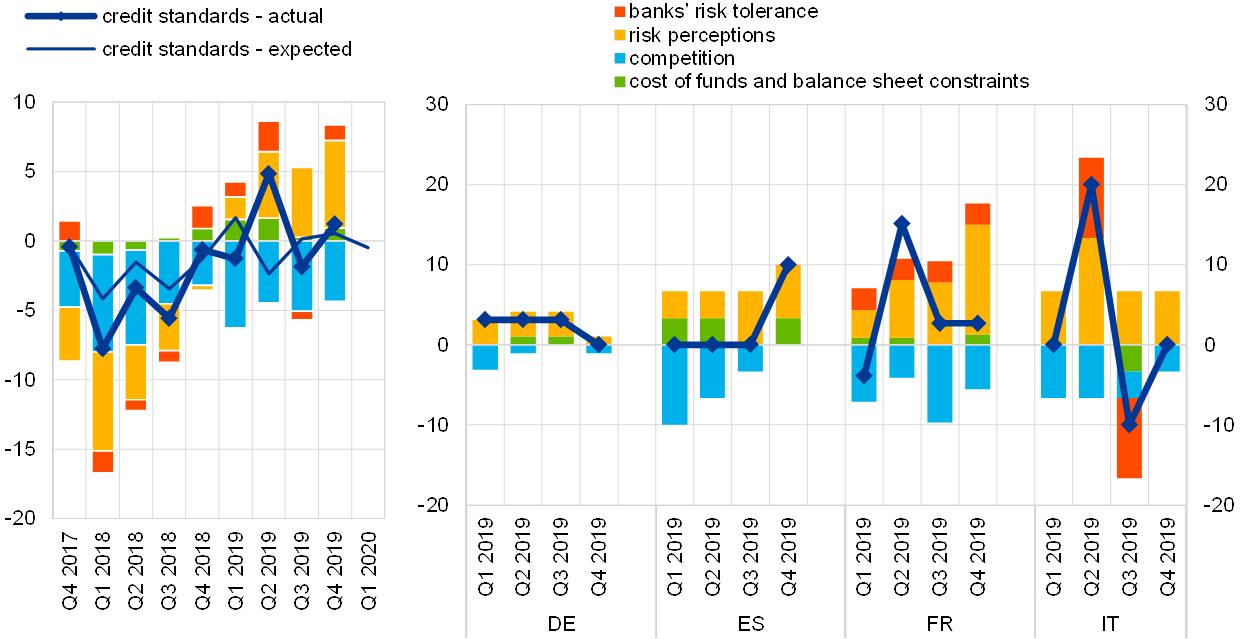
Notes: “Actual” values are changes that have occurred, while “expected” values are changes anticipated by banks. Net percentages are defined as the difference between the sum of the percentages of banks responding “tightened considerably” and “tightened somewhat” and the sum of the percentages of banks responding “eased somewhat” and “eased considerably”. The net percentages for responses to questions related to contributing factors are defined as the difference between the percentage of banks reporting that the given factor contributed to a tightening and the percentage reporting that it contributed to an easing. “Cost of funds and balance sheet constraints” is the unweighted average of “costs related to capital position”, “access to market financing” and “liquidity position”; “risk perceptions” is the unweighted average of “general economic situation and outlook”, “industry or firm-specific situation and outlook/borrower’s creditworthiness” and “risk related to the collateral demanded”; “competition” is the unweighted average of “competition from other banks”, “competition from non-banks” and “competition from market financing”.
Banks’ risk perceptions (owing to both the general economic situation and the firm‑specific situation) continued to have a tightening impact on credit standards for loans to enterprises. In contrast, competition (mainly from other banks) continued to have an easing impact (see Chart 1 and Table 1).[5] Banks’ risk tolerance, funding costs and balance sheet constraints had a broadly neutral impact overall.
Looking at the four largest euro area countries, credit standards for loans to enterprises tightened in Spain and France in the fourth quarter of 2019, while they remained unchanged in Germany and Italy.
Looking ahead to the first quarter of 2020, euro area banks expect credit standards for loans to enterprises to remain unchanged.
Table 1
Factors contributing to the net easing of credit standards for loans or credit lines to enterprises
(net percentages of banks)

Note: See the notes on Chart 1.
2.1.2 Terms and conditions on loans to enterprises remained unchanged
Overall terms and conditions on new loans or credit lines to enterprises (i.e. the actual terms and conditions agreed in loan contracts) remained unchanged in the fourth quarter of 2019 (see Chart 2 and Table 2). While margins on average loans to enterprises (defined as the spread over relevant market reference rates) narrowed, they continued to widen slightly for riskier loans. Most other credit terms and conditions (e.g. collateral requirements) remained broadly unchanged, while non‑interest rate charges increased.
Chart 2
Changes in terms and conditions on loans or credit lines to enterprises
(net percentages of banks reporting a tightening of terms and conditions)
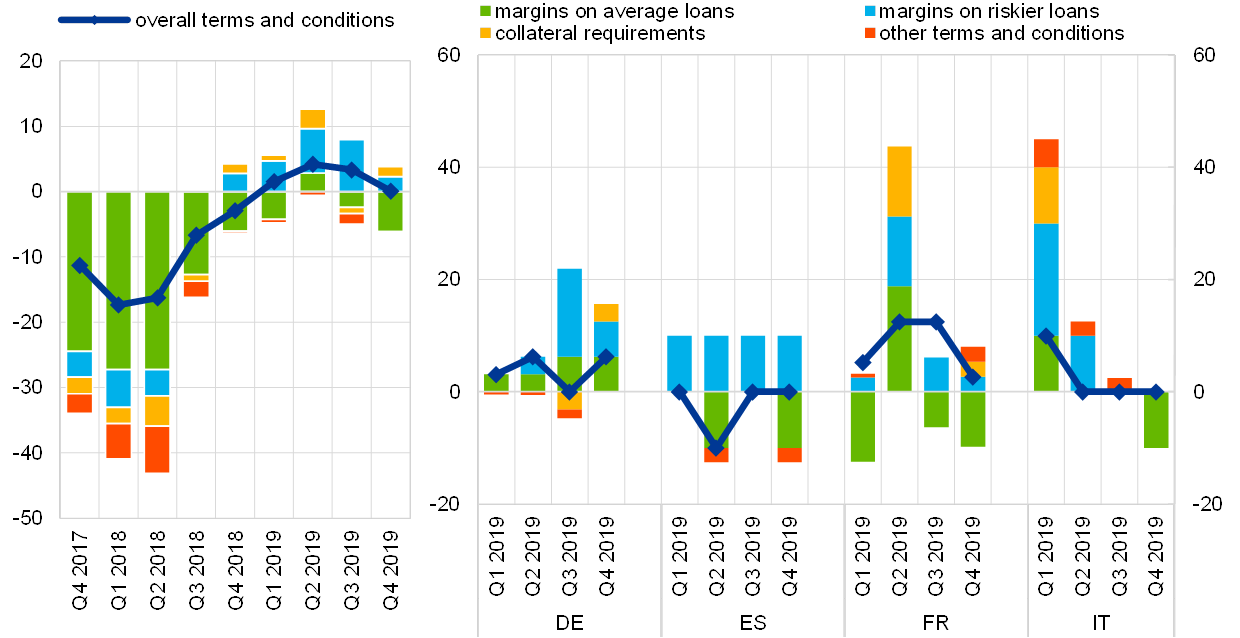
Notes: “Margins” are defined as the spread over a relevant market reference rate. “Other terms and conditions” is the unweighted average of “non-interest rate charges”, “size of the loan or credit line”, “loan covenants” and “maturity”.
Looking at the four largest euro area countries, overall terms and conditions on new loans or credit lines to enterprises tightened in Germany and France, while they remained unchanged in Spain and Italy. That tightening was driven mainly by a widening of margins on riskier loans. In Germany and France, collateral requirements exerted a tightening impact, while non-interest rate charges had a tightening impact overall in France and Spain. According to reporting banks, margins on average loans narrowed in Spain, France and Italy in the fourth quarter of 2019.
Table 2
Changes in terms and conditions on loans or credit lines to enterprises
(net percentages of banks)

Note: See the notes on Chart 2.
Banks’ funding costs, balance sheet constraints and risk perceptions were the main factors exerting a tightening impact, while competitive pressures continued to have an easing impact on overall terms and conditions (see Table 3). Banks’ increased risk tolerance also had a slight easing impact on term and conditions.
Table 3
Factors contributing to the net tightening of overall terms and conditions on loans or credit lines to enterprises
(net percentages of banks)

Note: The net percentages for these questions relating to contributing factors are defined as the difference between the percentage of banks reporting that the given factor contributed to a tightening and the percentage reporting that it contributed to an easing.
2.1.3 Rejection rate for loans to enterprises continued to increase
The net percentage share of rejected loan applications (calculated as the difference between the percentage of banks reporting an increase in rejection rates and the percentage of banks reporting a decline) continued to increase for loans to euro area enterprises in the fourth quarter of 2019, reaching the highest level seen since the series began in 2015 (9%, up from 7% in the previous quarter; see Chart 3).
Chart 3
Changes in the share of rejected applications for loans to enterprises
(net percentages of banks reporting an increase in the share of rejections)
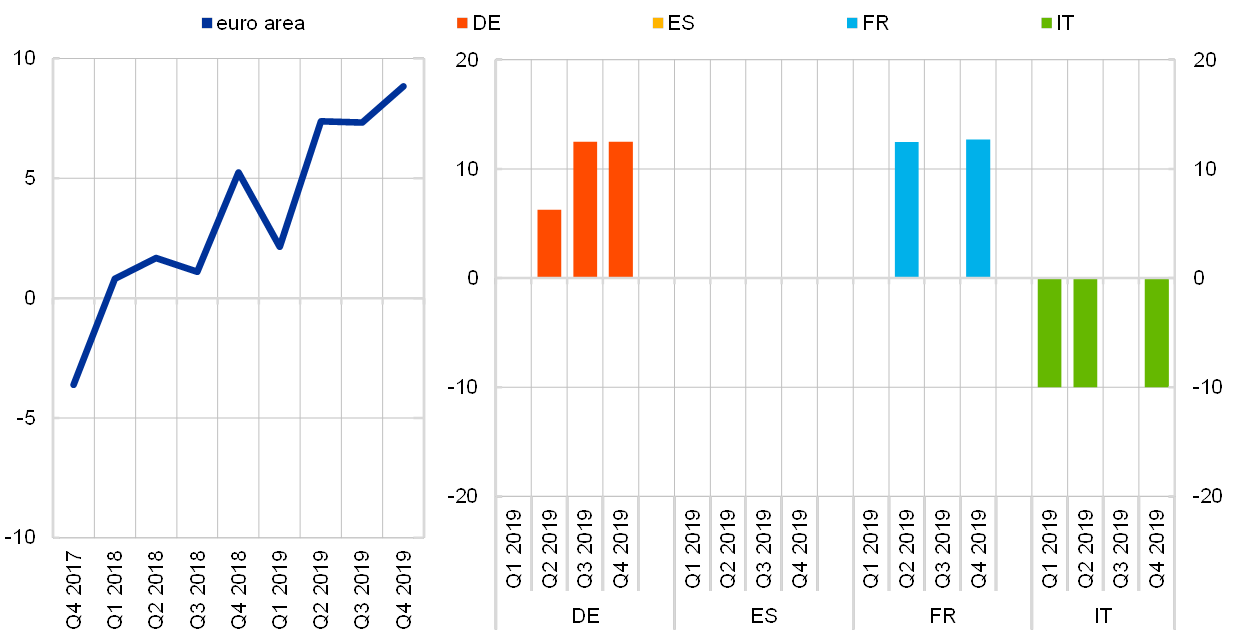
Note: Share of loan rejections relative to the volume of all loan applications in that loan category.
Looking at the largest euro area countries, the net rejection rate increased in France and Germany, while it remained unchanged in Spain and declined in Italy. The increase in the net rejection rate in Germany and France broadly corresponded to the tightening impact that risk perceptions had on credit standards for loans to enterprises as a result of concerns about borrowers’ creditworthiness.
2.1.4 Net demand for loans to enterprises declined
Net demand for loans to enterprises declined in the fourth quarter of 2019 (net percentage of -8%, down from 1% in the third quarter of 2019; see Chart 4 and overview table), the first time this had been seen since the fourth quarter of 2013, whereas banks had expected it to remain stable overall. That net decline in demand was broadly based across a number of larger and smaller euro area countries. Demand declined for both loans to SMEs and loans to large firms.
Chart 4
Changes in demand for loans or credit lines to enterprises, and contributing factors
(net percentages of banks reporting an increase in demand and contributing factors)
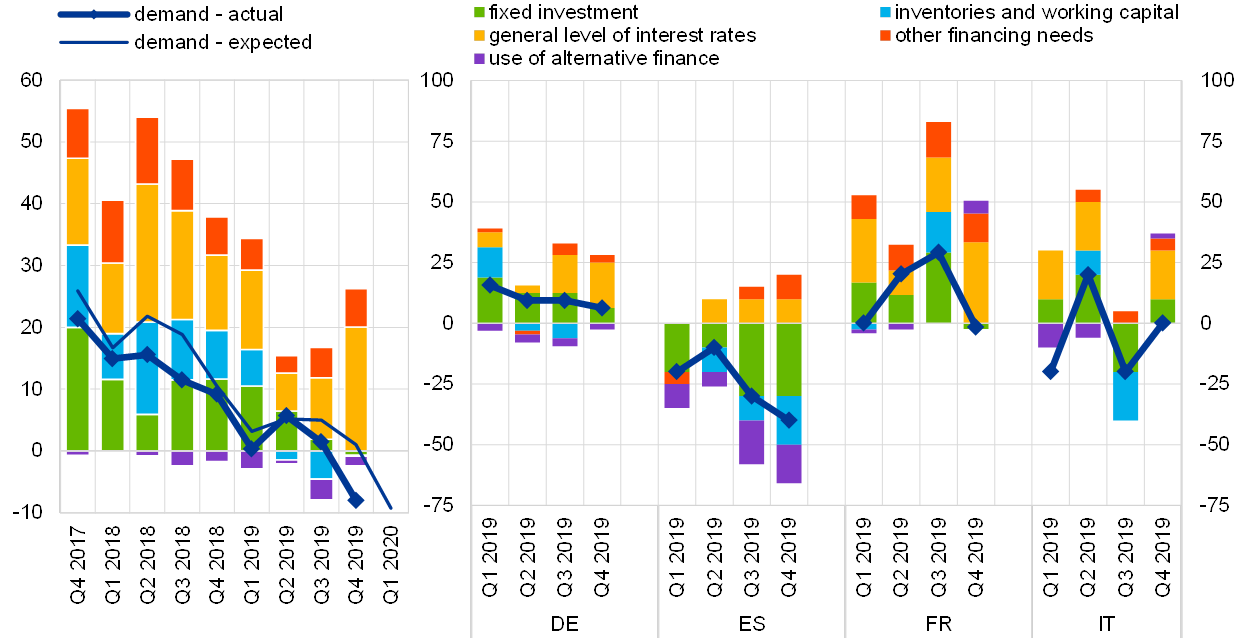
Notes: “Actual” values are changes that have occurred, while “expected” values are changes anticipated by banks. Net percentages for the questions on demand for loans are defined as the difference between the sum of the percentages of banks responding “increased considerably” and “increased somewhat” and the sum of the percentages of banks responding “decreased somewhat” and “decreased considerably”. The net percentages for responses to questions relating to contributing factors are defined as the difference between the percentage of banks reporting that the given factor contributed to increasing demand and the percentage reporting that it contributed to decreasing demand. “Other financing needs” is the unweighted average of “mergers/acquisitions and corporate restructuring” and “debt refinancing/restructuring and renegotiation”; “use of alternative finance” is the unweighted average of “internal financing”, “loans from other banks”, “loans from non-banks”, “issuance/redemption of debt securities” and “issuance/redemption of equity”.
Demand for loans to enterprises continued to be supported by the low general level of interest rates and, to a lesser extent, M&A activities (included in “other financing needs”; see Chart 4 and Table 4).[6] The positive contribution made by the low general level of interest rates increased relative to previous survey rounds.
Financing needs for fixed investment ceased to contribute positively to firms’ loan demand. While the contribution that individual factors make to net loan demand has mostly been positive or neutral on aggregate, a more detailed assessment offers additional insight. In fact, in most countries where banks indicated a net decline in demand, fixed investment contributed to that decline, in line with subdued economic activity. At the same time, in a few countries, firms’ internal funds also contributed to the dampening of loan demand, pointing to alternative funding options for companies.
Table 4
Factors contributing to net demand for loans or credit lines to enterprises
(net percentages of banks)

Note: See the notes on Chart 4.
Looking at the largest euro area countries, net demand for loans to enterprises declined in Spain and, to a lesser extent, France, while net demand increased in Germany and remained unchanged in Italy. Spain’s net decline in demand for loans to enterprises was driven by fixed investment, inventories and working capital, as well as the use of alternative finance. In contrast, the low general level of interest rates supported loan demand in all major euro area countries.
For the first quarter of 2020, banks expect that demand for loans to enterprises will continue to decline (net percentage of -9%).
2.2 Loans to households for house purchase
2.2.1 Credit standards for loans to households for house purchase remained broadly unchanged
Credit standards for loans to households for house purchase remained broadly unchanged in the fourth quarter of 2019, following the slight easing observed in the previous quarter (1%, compared with -2% in the previous quarter; see Chart 5 and overview table). This was in line with expectations. The net percentage remained below the historical average since 2003.
Chart 5
Changes in credit standards applied to the approval of loans to households for house purchase, and contributing factors
(net percentages of banks reporting a tightening of credit standards and contributing factors)
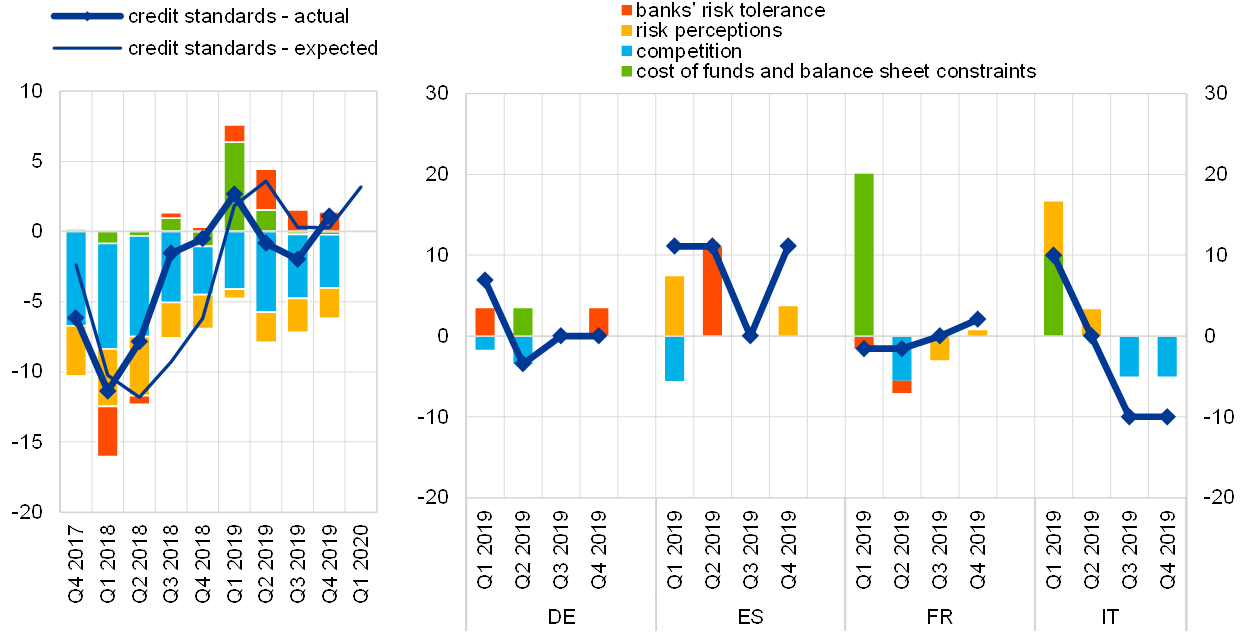
Notes: See the notes on Chart 1. “Risk perceptions” is the unweighted average of “general economic situation and outlook”, “housing market prospects, including expected house price developments” and “borrower’s creditworthiness”; “competition” is the unweighted average of “competition from other banks” and “competition from non-banks”.
Pressure from competition continued to be the main factor having an easing impact on credit standards. Risk perceptions also continued to have an easing impact (albeit to a lesser extent), owing to still favourable housing market prospects and borrowers’ creditworthiness. Banks’ risk tolerance, funding costs and balance sheet constraints had a broadly neutral impact (see Chart 5 and Table 5).
Looking at the largest euro area countries, banks tightened their credit standards in Spain and France, while they left them unchanged overall in Germany (despite a tightening impact stemming from banks’ risk tolerance), and they eased them in Italy. The tightening reported in Spain was driven mainly by risk perceptions relating to economic activity.
Looking ahead, euro area banks expect that credit standards for housing loans will tighten (net percentage of 3%) in the first quarter of 2020.
Table 5
Factors contributing to the net tightening of credit standards for loans to households for house purchase
(net percentages of banks)

Note: See the notes on Chart 5.
2.2.2 Terms and conditions on loans to households for house purchase remained broadly unchanged
Banks’ overall terms and conditions on new loans to households for house purchase remained broadly unchanged in the fourth quarter of 2019 (see Chart 6 and Table 6), following a tightening in the previous quarter. The compression of margins on average loans had an easing impact on banks’ overall terms and conditions, while the tightening impact of margins on riskier loans was weaker than in the last survey round. Loan-to-value ratios (included in “other terms and conditions”) also exerted a tightening impact.
Chart 6
Changes in terms and conditions on loans to households for house purchase
(net percentages of banks reporting a tightening of terms and conditions)
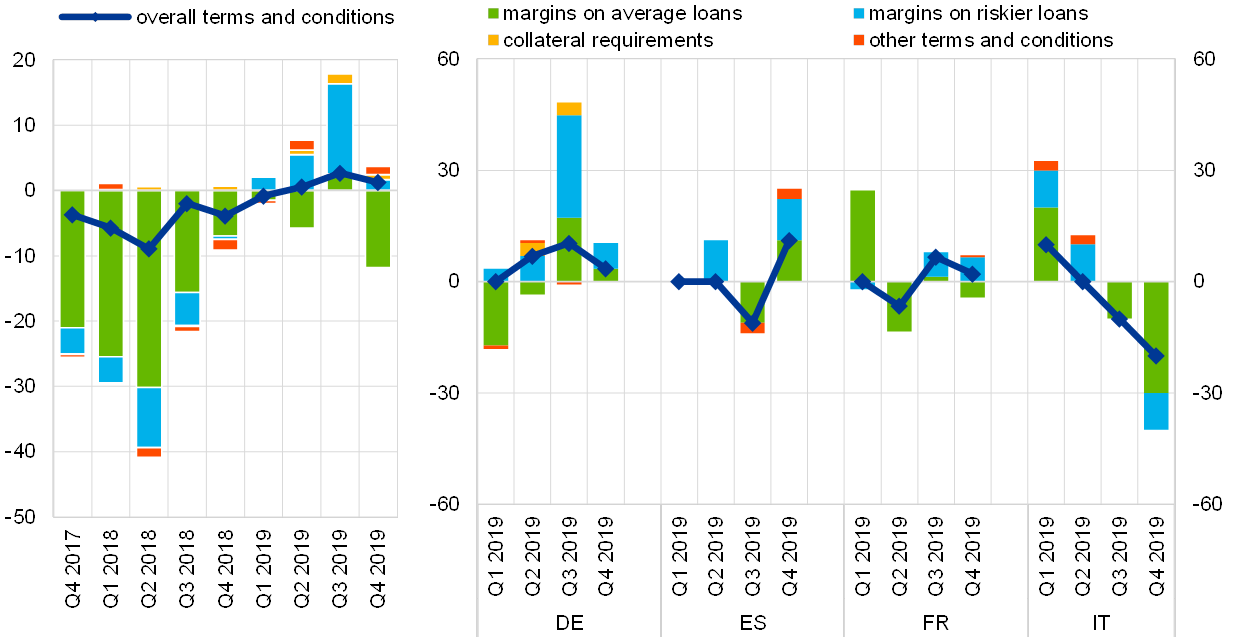
Notes: “Margins” are defined as the spread over a relevant market reference rate. “Other terms and conditions” is the unweighted average of “loan-to-value ratio”, “other loan size limits”, “non-interest rate charges” and “maturity”.
Looking at the largest euro area countries, banks in Spain and Germany reported a tightening of overall terms and conditions on housing loans, driven by a widening of margins on both average and riskier loans and, in the case of Germany, a small net tightening impact of loan-to-value ratios. Banks in France reported a slight tightening of overall terms and conditions, driven by an increase in margins on riskier loans which was only partially offset by narrower margins on average loans. In contrast, banks in Italy reported a net easing of terms and conditions, driven mainly by narrower margins for both average and riskier loans.
Table 6
Changes in terms and conditions on loans to households for house purchase
(net percentages of banks)

Note: See the notes on Chart 6.
Competitive pressures remained the main factor having an easing impact on overall terms and conditions on housing loans at euro area level. Meanwhile, banks’ risk tolerance, funding costs and balance sheet constraints had a tightening impact (see Table 7). Risk perceptions also had a slight tightening impact on terms and conditions on housing loans at euro area level.
Table 7
Factors contributing to the net tightening of overall terms and conditions on loans to households for house purchase
(net percentages of banks)

Note: The net percentages for these questions relating to contributing factors are defined as the difference between the percentage of banks reporting that the given factor contributed to a tightening and the percentage reporting that it contributed to an easing.
2.2.3 Rejection rate for housing loans increased
According to euro area banks, the net share of rejected applications for loans to households for house purchase increased again in the fourth quarter of 2019 (net percentage of 3%, unchanged from the previous survey round; see Chart 7).
Looking at the largest euro area countries, the rejection rate for housing loans increased in France, while it remained unchanged in Germany and declined in both Spain and Italy. The increase in the net rejection rate in France coincided with an increase in demand for housing loans, which may suggest that banks received a larger percentage of applications with lower credit quality.
Chart 7
Change in the share of rejected applications for loans to households for house purchase
(net percentages of banks reporting an increase in the share of rejections)
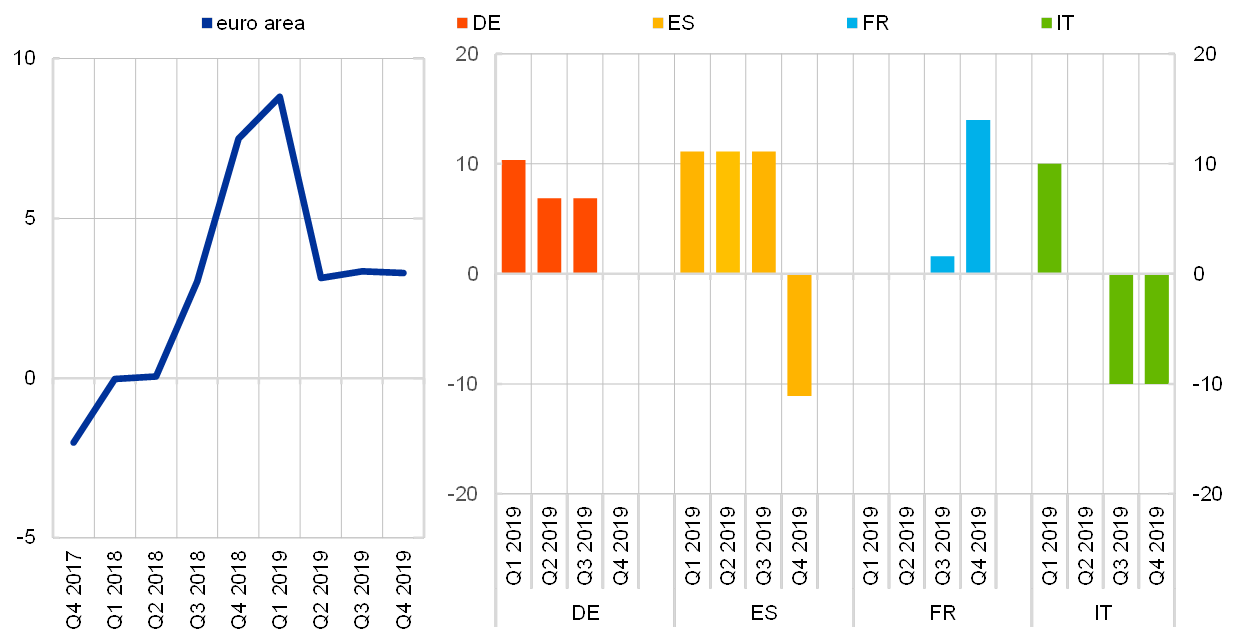
Note: Share of loan rejections relative to the volume of all loan applications in that loan category.
2.2.4 Net demand for housing loans continued to increase
In the fourth quarter of 2019, banks reported a further strengthening of net demand for housing loans (net percentage of 25%, up from 15% in the previous quarter; see Chart 8 and overview table), which was above the historical average for housing loan demand and higher than banks had expected in the previous survey round.
Chart 8
Changes in demand for loans to households for house purchase, and contributing factors
(net percentages of banks reporting an increase in demand and contributing factors)

Notes: See the notes on Chart 4. “Other financing needs” is the unweighted average of “debt refinancing/restructuring and renegotiation” and “regulatory and fiscal regime of housing markets”; “use of alternative finance” is the unweighted average of “internal finance of house purchase out of savings/down payment”, “loans from other banks” and “other sources of external finance”.
Net demand for housing loans continued to be driven mainly by the low general level of interest rates, while favourable housing market prospects and consumer confidence also contributed more positively than in previous quarters. Other financing needs (such as debt refinancing/restructuring and the regulatory and fiscal regime governing housing markets) also had a positive impact. However, the use of alternative sources of finance continued to have a slight negative effect on demand (see Chart 8 and Table 8).
Looking at the largest euro area countries, net demand increased in France, Germany and Italy, but it fell in Spain, where it declined for the second consecutive quarter. In Spain, banks cited housing market prospects, consumer confidence and the use of alternative finance as the main factors dampening demand for housing loans. Demand in France, Italy and Germany was supported by the low general level of interest rates, favourable housing market prospects and, to a lesser extent, consumer confidence.
Table 8
Factors contributing to net demand for loans to households for house purchase
(net percentages of banks)

Note: See the notes on Chart 8.
For the first quarter of 2020, euro area banks expect a continued increase in net demand for housing loans (6%).
2.3 Consumer credit and other lending to households
2.3.1 Credit standards for consumer credit and other lending to households continued to tighten
In the fourth quarter of 2019, credit standards for consumer credit and other lending to households tightened further (net percentage of 3%, unchanged from the previous quarter; see Chart 9 and overview table), despite expectations that they would remain broadly unchanged. That net percentage was around the historical average since 2003.
Chart 9
Changes in credit standards applied to the approval of consumer credit and other lending to households, and contributing factors
(net percentages of banks reporting a tightening of credit standards and contributing factors)
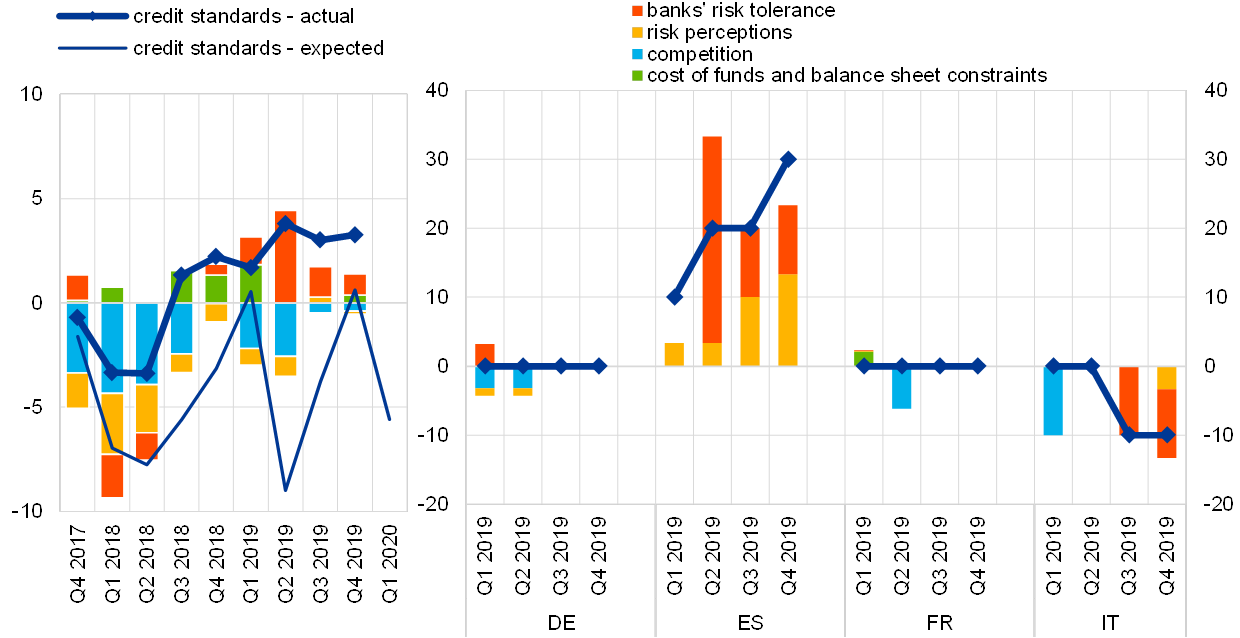
Notes: See the notes on Chart 1. “Risk perceptions” is the unweighted average of “general economic situation and outlook”, “creditworthiness of consumers” and “risk on the collateral demanded”; “competition” is the unweighted average of “competition from other banks” and “competition from non-banks”.
Overall, banks’ risk tolerance, risk perceptions, competition, funding costs and balance sheet constraints had a broadly neutral impact on credit standards for consumer credit at euro area level in the fourth quarter of 2019 (see Chart 9 and Table 9).
Looking at the largest euro area countries, credit standards for consumer lending continued to tighten in Spain, while they remained unchanged in Germany and France, and eased in Italy. The tightening reported in Spain was driven mainly by risk perceptions and a decline in banks’ risk tolerance.
Looking ahead to the first quarter of 2020, euro area banks expect a net easing of credit standards for consumer credit and other lending to households (-6%).
Table 9
Factors contributing to the net tightening of credit standards for consumer credit and other lending to households
(net percentages of banks)
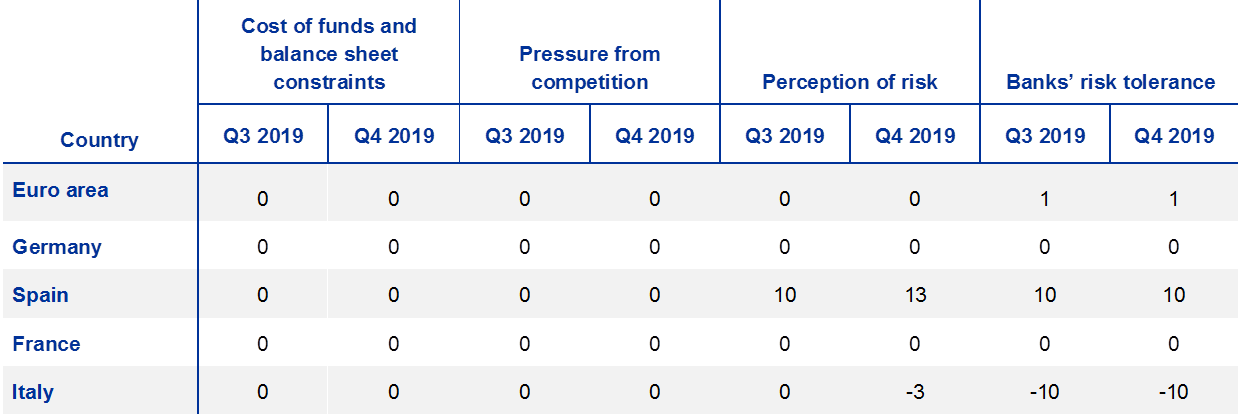
Note: See the notes on Chart 9.
2.3.2 Terms and conditions on consumer credit and other lending to households eased
In the fourth quarter of 2019, the overall terms and conditions applied by banks when granting new consumer credit and other lending to households eased, driven mainly by the compression of margins on average loans. At the same time, margins on riskier loans widened slightly, and collateral requirements and the size of loans (included in “other terms and conditions”) also had a slight tightening impact (see Chart 10 and Table 10).
Looking at the largest euro area countries, overall terms and conditions on consumer credit and other lending to households eased in France, Spain and Germany, but remained unchanged in Italy. Similarly, margins on average loans narrowed in France, Spain and Germany, but widened in Italy. The narrowing of margins on average loans was partially offset by wider margins on riskier loans in Spain and France, as well as higher collateral requirements in Spain.
Chart 10
Changes in terms and conditions on consumer credit and other lending to households
(net percentages of banks reporting a tightening of terms and conditions)
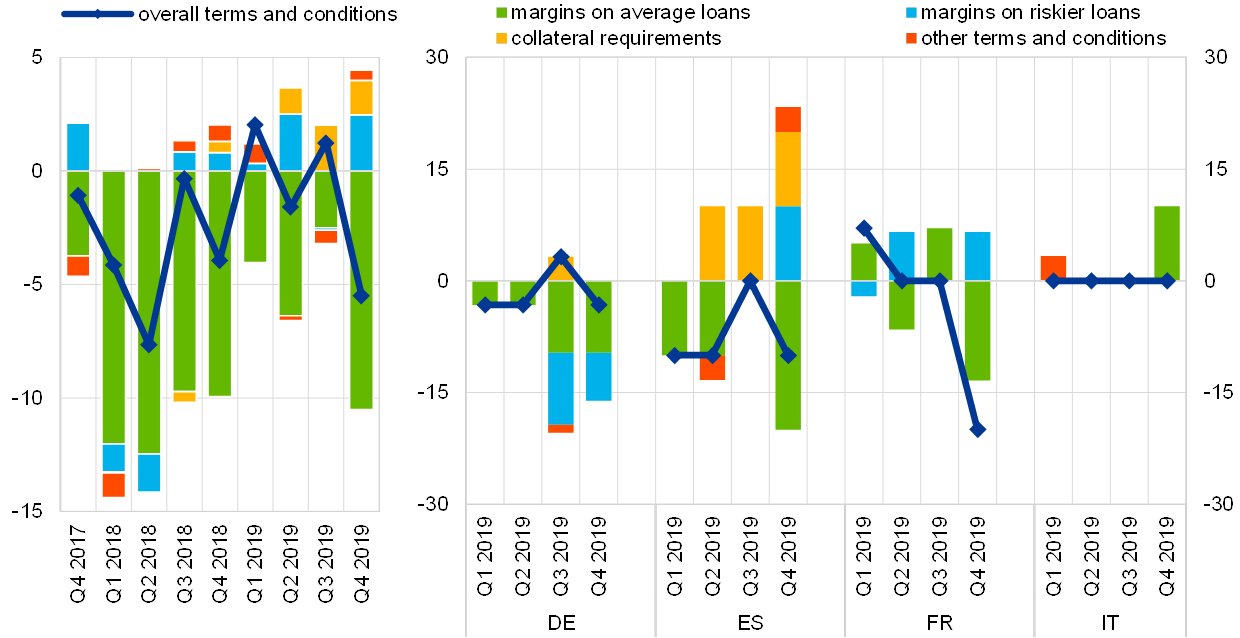
Notes: “Margins” are defined as the spread over a relevant market reference rate. “Other terms and conditions” is the unweighted average of “size of the loan”, “non-interest rate charges” and “maturity”.
Table 10
Changes in terms and conditions on consumer credit and other lending to households
(net percentages of banks)

Note: See the notes on Chart 10.
The main factor underlying the net easing of overall terms and conditions was pressure from competition, while banks’ risk tolerance exerted a slight tightening impact. Banks’ funding costs, balance sheet constraints and risk perceptions had a broadly neutral impact overall (see Table 11).
Table 11
Factors contributing to the net tightening of overall terms and conditions on consumer credit and other lending to households
(net percentages of banks)
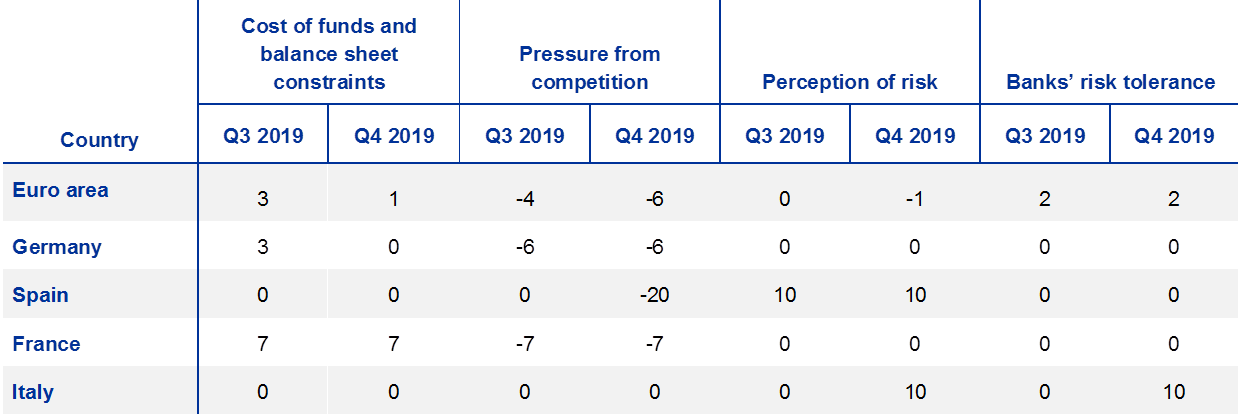
Note: The net percentages for these questions relating to contributing factors are defined as the difference between the percentage of banks reporting that the given factor contributed to a tightening and the percentage reporting that it contributed to an easing.
2.3.3 Rejection rate for consumer credit and other lending to households increased slightly
The net share of rejected applications for consumer credit and other lending to households continued to increase slightly in the fourth quarter of 2019 according to reporting banks (net percentage of 2%, compared with 6% in the previous survey round; see Chart 11).
Looking at the largest euro area countries, the rejection rate increased in Spain, while it remained unchanged in Germany, France and Italy. The increase seen in Spain since the beginning of 2019 may be explained by the tightening impact that risk perceptions have had on credit standards for consumer credit and other lending to households.
Chart 11
Change in the share of rejected applications for consumer credit and other lending to households
(net percentages of banks reporting an increase in the share of rejections)
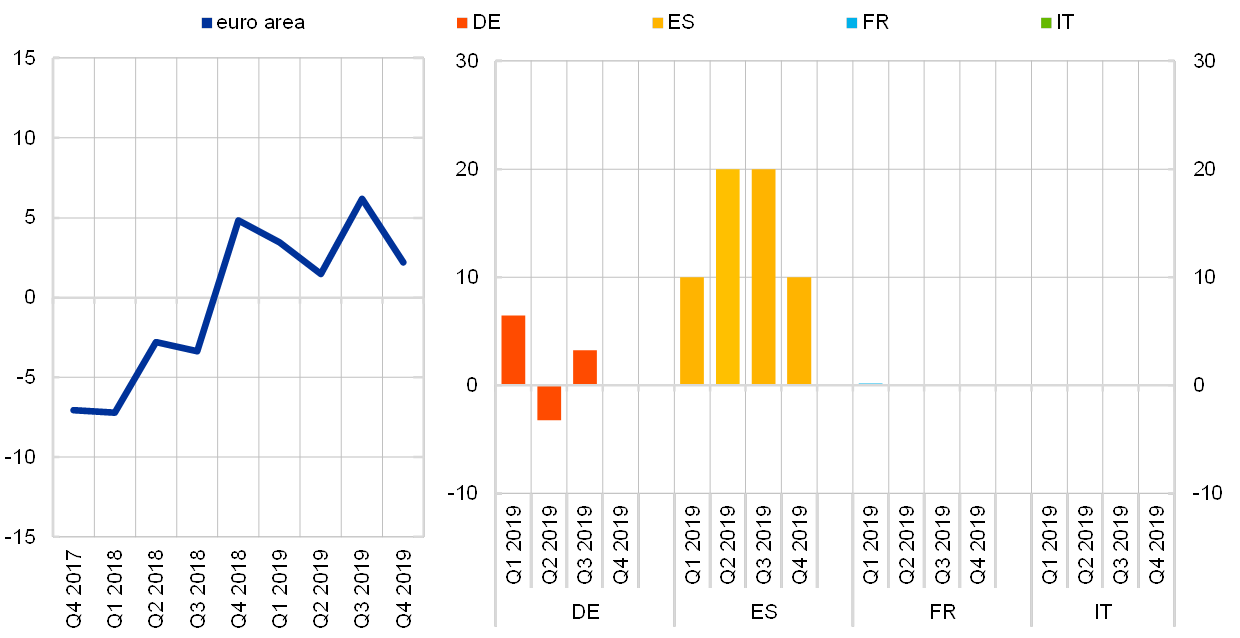
Note: Share of loan rejections relative to the volume of all loan applications in that loan category.
2.3.4 Net demand for consumer credit and other lending to households continued to increase
According to euro area banks, net demand for consumer credit and other lending to households increased in the fourth quarter of 2019 (net percentage of 10%, up from 8% in the previous quarter; see Chart 12 and overview table). Net demand in the fourth quarter was higher than its historical average, but weaker than had been expected in the previous survey round.
The low general level of interest rates, consumer confidence and increased spending on durable goods all had a positive impact on demand for consumer credit (see Chart 12 and Table 12). Other factors, such as the use of alternative finance and consumption expenditure financed through real estate-guaranteed loans, had a broadly neutral impact on demand.
Looking at the largest euro area countries, net demand for consumer credit and other lending to households increased in Italy, France and Germany, while it declined in Spain. The low general level of interest rates supported demand in Italy, France and Germany, but had a neutral impact in Spain.
Chart 12
Changes in demand for consumer credit and other lending to households, and contributing factors
(net percentages of banks reporting an increase in demand and contributing factors)
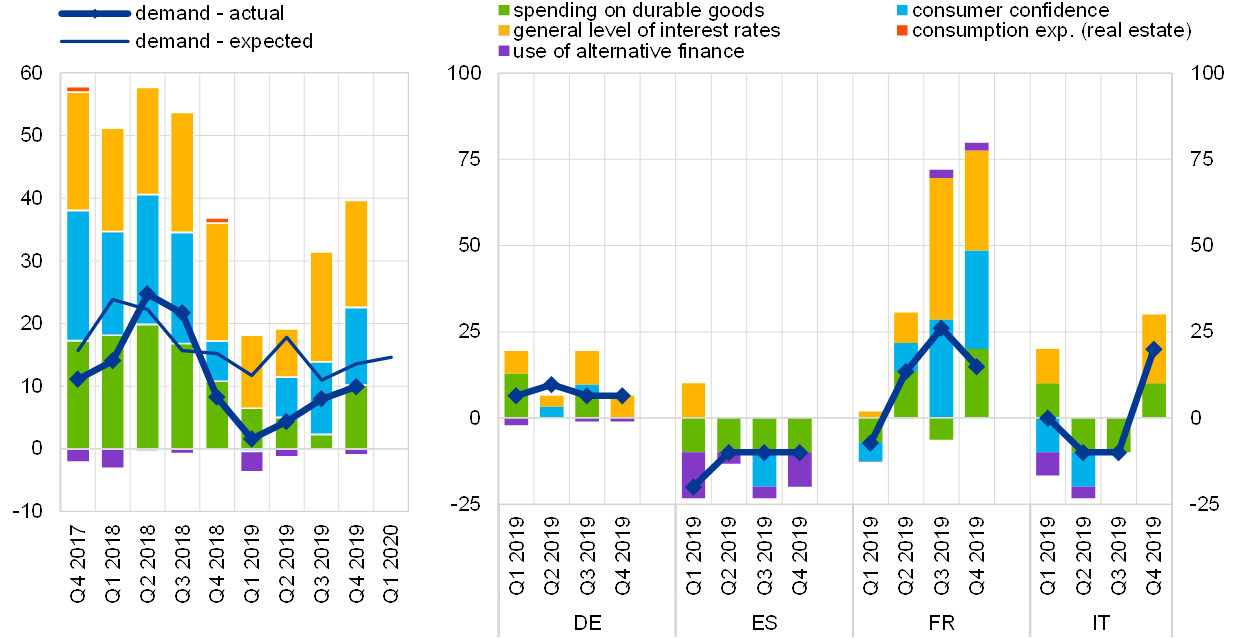
Notes: See the notes on Chart 4. “Use of alternative finance” is the unweighted average of “internal financing out of savings”, “loans from other banks” and “other sources of external finance”. “Consumption exp. (real estate)” denotes “consumption expenditure financed through real estate-guaranteed loans”.
Table 12
Factors contributing to net demand for consumer credit and other lending to households
(net percentages of banks)

Note: See the notes on Chart 12.
For the first quarter of 2020, euro area banks expect net demand for consumer credit and other lending to households to increase further (15%).
3 Ad hoc questions
3.1 Banks’ access to retail and wholesale funding
The January 2020 survey included a question assessing the extent to which the situation in financial markets had affected banks’ access to retail and wholesale funding. Banks were asked whether their access to funding had deteriorated or eased over the past three months, as well as being asked about their expectations for the next three months. Here, negative net percentages indicate an improvement, while positive figures indicate a deterioration in net terms.
Euro area banks reported in net terms that their access to wholesale funding had continued to improve in the fourth quarter of 2019 as regards debt securities issuance (see Chart 13 and Table 13), driven by medium to long-term bonds. Access to securitisation was also said to have improved, owing mainly to securitisation of housing loans.[7] In contrast, access to money markets remained unchanged, following improvements in previous quarters. As regards retail funding, access to short and longer-term deposit funding was reported to have remained broadly unchanged.
Chart 13
Banks’ assessment of funding conditions and the ability to transfer credit risk off the balance sheet
(net percentages of banks reporting a deterioration in market access)
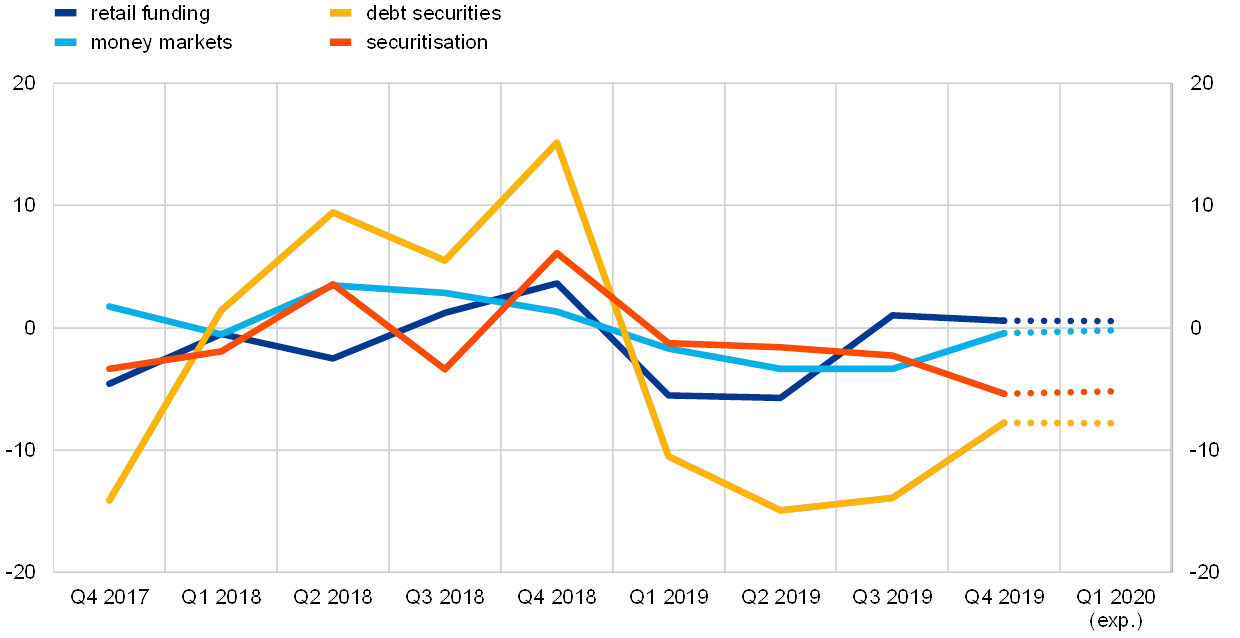
Note: These net percentages are defined as the difference between the sum of the percentages for “deteriorated considerably” and “deteriorated somewhat” and the sum of the percentages for “eased somewhat” and “eased considerably”.
Looking ahead to the first quarter of 2020, euro area banks expect developments in terms of access to retail and wholesale funding to be similar to those seen in the fourth quarter of 2019.
Table 13
Banks’ assessment of funding conditions and the ability to transfer credit risk off the balance sheet
(net percentages of banks reporting a deterioration in market access)

Note: See the notes on Chart 13.
3.2 Banks’ adjustment to regulatory and supervisory action
The January 2020 BLS questionnaire included a biannual ad hoc question assessing the extent to which new regulatory or supervisory requirements affect banks’ lending policies via the potential impact on capital, leverage, liquidity positions or provisioning and the credit conditions that banks apply to loans. Here, “new requirements” encompasses both regulatory/supervisory measures that have recently been implemented and measures that are expected to be implemented in the near future. Banks were also asked to indicate the impact on their funding conditions.
Chart 14
Impact of regulatory or supervisory action on banks’ risk-weighted assets, capital and funding conditions
(net percentages of banks)
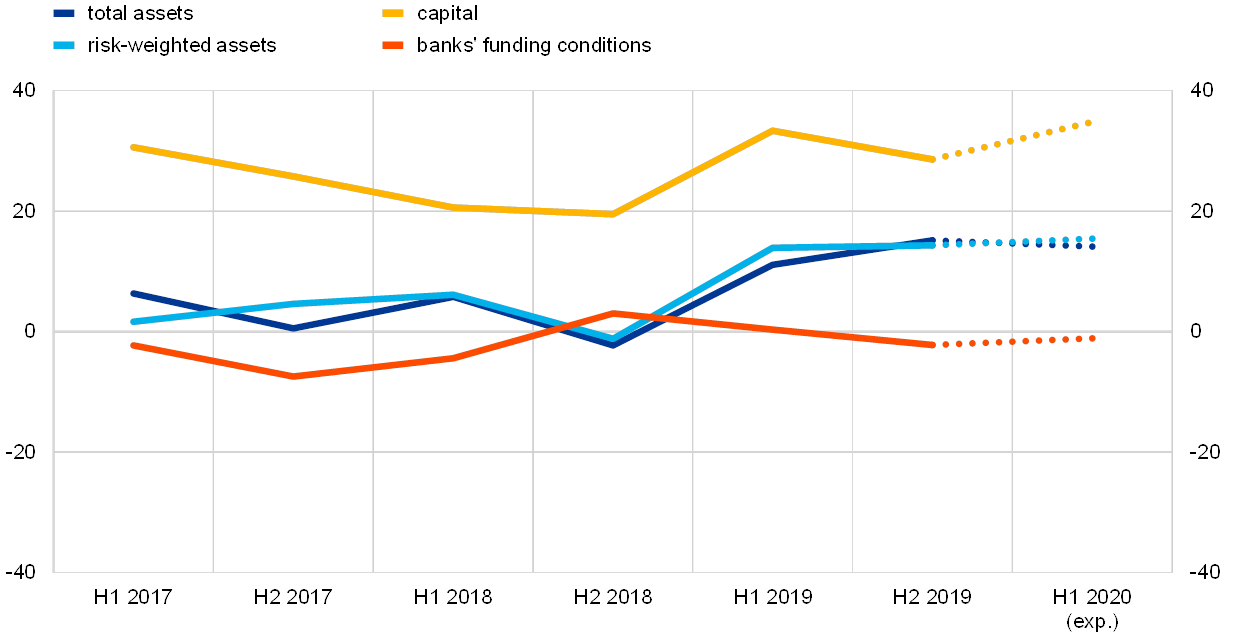
Notes: For “total assets”, “risk-weighted assets” and “capital”, the net percentages are defined as the difference between the sum of the percentages for “increased considerably” and “increased somewhat” and the sum of the percentages for “decreased somewhat” and “decreased considerably”. For “banks’ funding conditions”, the net percentages are defined as the difference between the sum of the percentages for “experienced a considerable tightening” and “experienced a moderate tightening” and the sum of the percentages for “experienced a moderate easing” and “experienced a considerable easing”.
Table 14
Impact of regulatory or supervisory action on banks’ risk-weighted assets, capital and funding conditions
(net percentages)

Note: See the notes on Chart 14.
Euro area banks reported a continued strengthening of their capital position in response to new regulatory or supervisory requirements in the second half of 2019 (see Chart 14 and Table 14), with that strengthening being driven by both retained earnings and capital issuance. In addition, new regulatory or supervisory requirements also led to an increase in banks’ total assets and liquid assets in the second half of 2019. Banks also reported an increase in risk-weighted assets, driven mainly by average loans, while the contribution of riskier loans was broadly neutral. Banks reported that regulatory or supervisory action had a slight easing impact on funding conditions.
Chart 15
Contribution of regulatory or supervisory action to the tightening of banks’ credit standards and margins
(net percentages of banks)
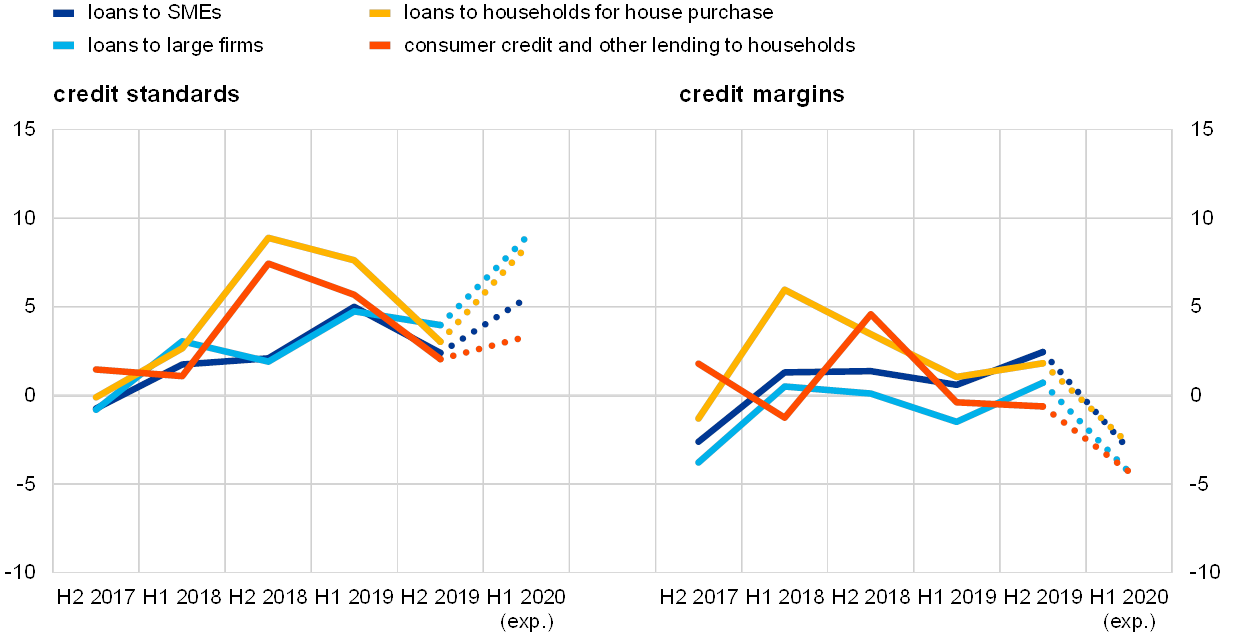
Notes: These net percentages are defined as the difference between the sum of the percentages for “tightened considerably” and “tightened somewhat” and the sum of the percentages for “eased somewhat” and “eased considerably”.
In the second half of 2019, supervisory or regulatory action continued to have a net tightening impact on banks’ credit standards across all loan categories, but that impact was weaker than it had been in the first half of 2019 (see Chart 15 and Table 15). For credit margins, banks reported either a broadly neutral impact or a slight tightening impact.
Looking ahead to the first half of 2020, euro area banks expect regulatory or supervisory action to lead to further strengthening of their capital positions and increases in both total and risk-weighted assets. In addition, they also expect regulatory or supervisory action to have a somewhat stronger tightening impact on credit standards and a narrowing impact on credit margins across loan categories.
Table 15
Contribution of regulatory or supervisory action to the tightening of banks’ credit standards and margins
(net percentages)

Note: See the notes on Chart 15.
3.3 The impact of banks’ NPL ratios on their lending policies
The January 2020 survey questionnaire included a biannual ad hoc question about the impact that banks’ NPL ratios have on their lending policies and the factors through which NPL ratios contribute to changes in lending policies. Banks were asked about the impact on loans to enterprises, loans to households for house purchase, and consumer credit and other lending to households over the past six months and over the next six months.
In the second half of 2019, euro area banks’ NPL ratios had a small net tightening impact on the credit standards applied to loans to enterprises and consumer credit (net percentage of 2% for both) and a broadly neutral impact on the credit standards applied to housing loans (see Chart 16), following a net tightening impact across all loan categories in the first half of 2019. NPL ratios had a small net tightening impact on the terms and conditions of loans to enterprises (net percentage of 2%), but the terms and conditions of other types of loan were broadly unaffected by NPL ratios in net terms.
Most of the tightening impact that NPL ratios had on bank lending conditions in the second half of 2019 came via banks’ reduced risk tolerance (net percentage of 9%) and risk perceptions relating to the general economic outlook and borrowers’ creditworthiness (net percentage of 3%; see Chart 17). In contrast, there was less pressure on credit standards as a result of supervisory or regulatory requirements (net percentage of -3%). For all other factors, the impact was broadly neutral at euro area level.
Chart 16
Impact of banks’ NPL ratios on credit standards and terms and conditions
(net percentages of banks)
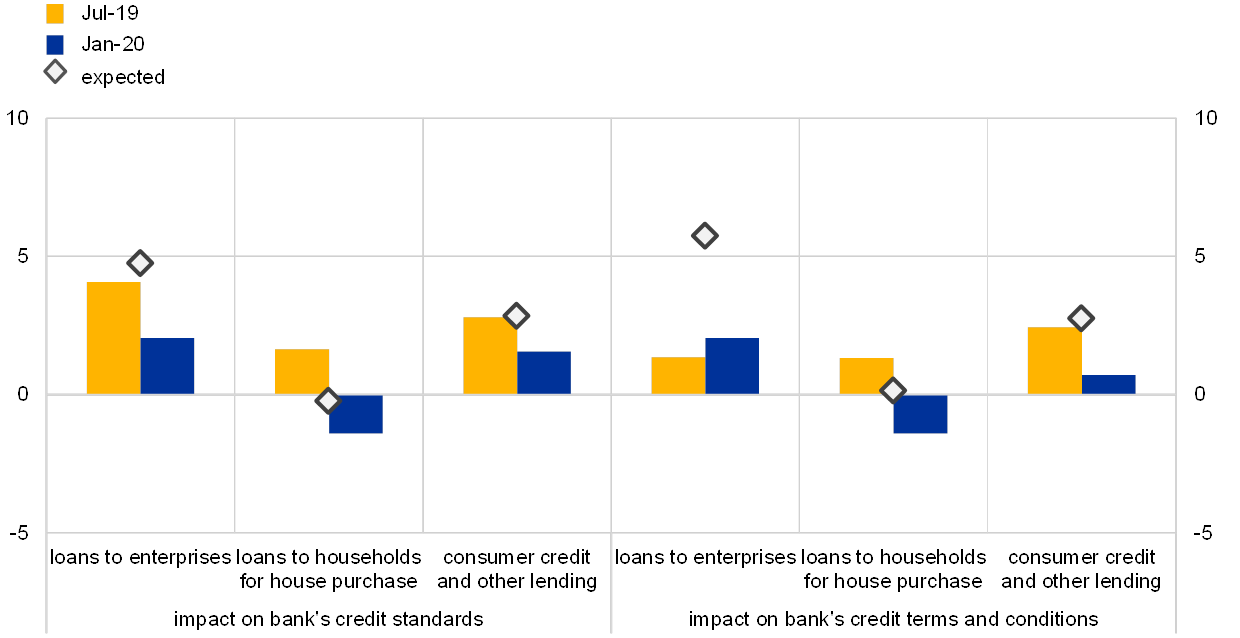
Notes: The NPL ratio is defined as the stock of gross NPLs on a bank’s balance sheet as a percentage of the gross carrying amount of loans. Changes in credit standards and/or terms and conditions can be caused by changes to the NPL ratio or by changes to regulations or the bank’s assessment of the level of the NPL ratio. Net percentages are defined as the difference between the sum of the percentages for “contributed considerably to tightening” and “contributed somewhat to tightening” and the sum of the percentages for “contributed somewhat to easing” and “contributed considerably to easing”.
Over the next six months, euro area banks expect their NPL ratios to have a somewhat stronger net tightening impact on credit standards as well as terms and conditions for loans to enterprises and consumer credit, but they do not expect any changes for housing loans. The most relevant factors for the tightening impact of NPL ratios are expected to be banks’ risk tolerance, liquidity positions and risk perceptions relating to the economic outlook.
Chart 17
Contributions of factors through which NPL ratios affect banks’ policies on lending to enterprises and households
(net percentages of banks)
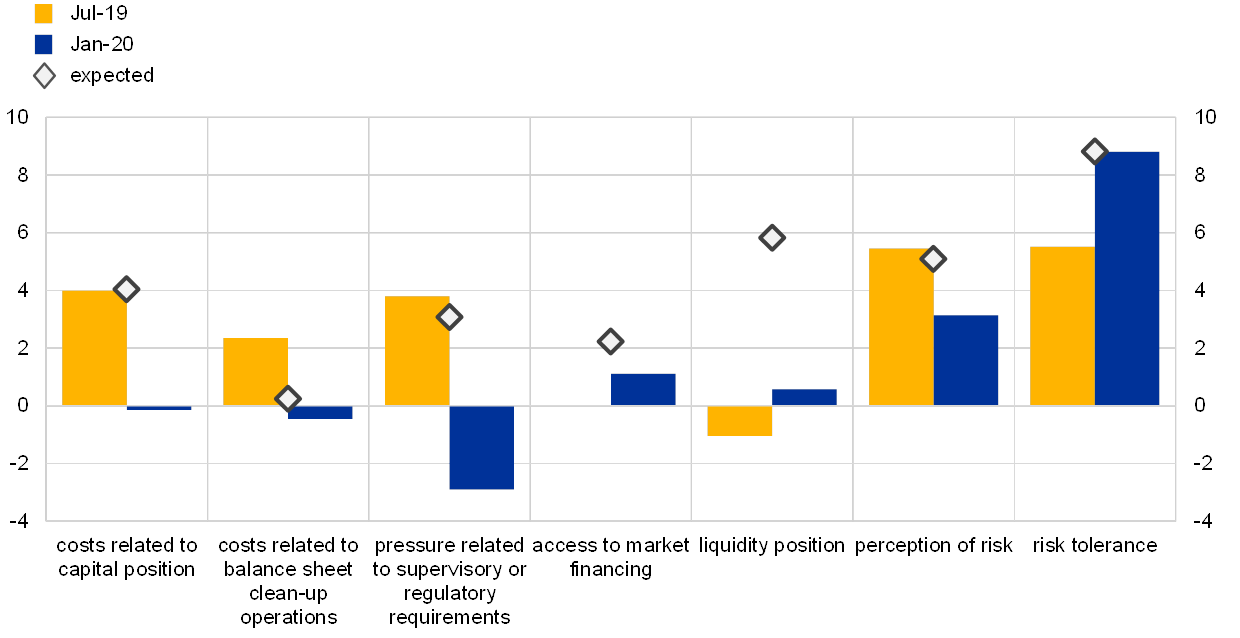
Notes: See the notes on Chart 16.
3.4 The impact of the TLTRO-III series on banks and their lending policies
The January 2020 survey questionnaire included an ad hoc question on the impact of the Eurosystem’s third series of targeted longer-term refinancing operations over the past six months and the next six months. Banks were asked about their participation in that series of operations and their reasons for doing so, as well as being asked about their use of TLTRO-III liquidity. In addition, banks were asked about the impact that TLTRO-III operations have on their financial situation, as well as lending conditions and lending volumes for loans to enterprises, loans to households for house purchase, and consumer credit and other lending to households.
Following the low participation rate that was observed for the first TLTRO-III operation in September 2019, the participation rate among respondent banks taking part in the BLS was higher (at 35%) for the second TLTRO-III operation in December 2019 (see Chart 18). Just under half of respondent banks (47%) intend to participate in future TLTRO-III operations, which would represent a further increase relative to the second operation.
Chart 18
Banks’ participation in TLTRO-III operations and their reasons for participation
(percentages of banks)
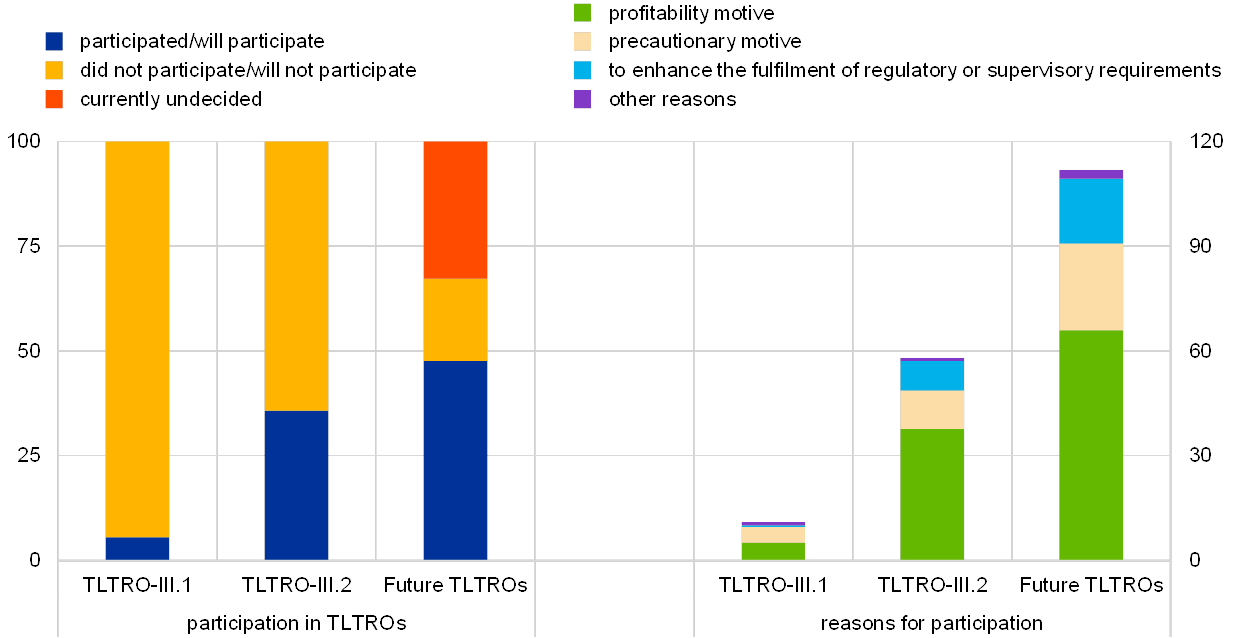
Notes: The TLTRO-III.1 corresponds to the “next to last TLTRO” in the questionnaire. The TLTRO-III.2 corresponds to the “most recent TLTRO”. Banks were asked to rate all reasons in terms of the extent to which they have contributed to their participation in TLTRO-III operations. “Other reasons” are specific reasons cited by banks that were not included in the questionnaire.
Given the attractive conditions surrounding TLTRO-III operations, the profitability motive was the most important factor in banks’ participation in the second TLTRO-III operation (see Chart 18), while the precautionary motive (i.e. the desire to prevent or reduce funding difficulties) also played a role. In addition, the need to fulfil regulatory or supervisory requirements also contributed to participation, with the contribution that TLTRO-II funds make to the fulfilment of the net stable funding ratio (NSFR) being reduced when the residual maturity falls below one year and dropping out entirely when it is less than six months. For future TLTRO-III operations, the relative importance of the various factors is broadly the same as that observed for the second operation.
Banks indicated that they used the TLTRO-III liquidity largely for granting loans to the non-financial private sector (see below for information across loan categories). At the same time, against the backdrop of the limited participation in the first TLTRO-III operation and possible uncertainty regarding the use of some funds from the second TLTRO-III operation, the information provided by banks on the use of TLTRO-III liquidity over the past six months was limited overall. The second most frequently cited use for TLTRO-III liquidity was refinancing – primarily the replacement of TLTRO-II funds (see Chart 19). This is likely to be related to the reduced relevance of TLTRO-II liquidity for the fulfilment of the NSFR, given the declining residual maturity.
In the future, too, banks plan to use TLTRO-III funds primarily for granting loans and replacing TLTRO-II funds. A number of other uses were cited by more banks for funds derived from future operations, such as holding liquidity with the Eurosystem and, to a lesser extent, the purchasing of financial assets (mainly domestic sovereign bonds). In terms of refinancing, besides the replacement of TLTRO-II funding, the replacement of maturing debt securities, interbank lending and deposit shortfalls are also expected to gain in importance.
Chart 19
Use of TLTRO-III liquidity by banks
(percentages of banks)
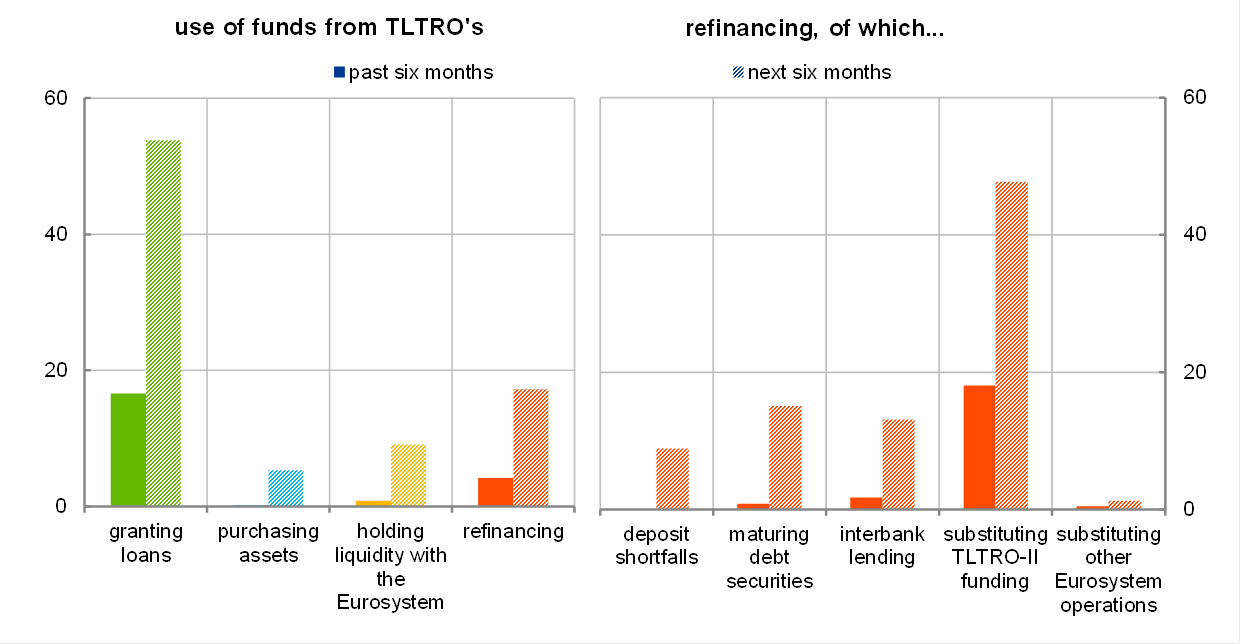
Notes: Solid bars indicate developments over the past six months, while patterned bars indicate expected developments over the next six months. Banks were asked to indicate the relevance of all purposes. "Purchasing financial assets" is the sum of “purchasing domestic sovereign bonds” and “purchasing other financial assets”. “Granting loans” refers to loans to the non-financial private sector.
Banks reported that TLTRO-III operations had a positive impact on their financial situation overall, particularly as regards their liquidity positions and market financing conditions (see Chart 20). In net terms, 20% of banks reported that the TLTRO-III operations had a positive impact on their liquidity positions over the past six months (a period including the September 2019 and December 2019 TLTRO-III operations), with 16% reporting a positive impact on their market financing conditions.
Over the next six months, banks expect the positive impact of TLTRO-III operations to increase. In addition to a positive impact on banks’ liquidity positions (net percentage of 41%) and market financing conditions (net percentage of 34%), a substantial net percentage of banks (37%) also expect a positive impact on profitability.
Chart 20
Impact of the TLTRO-III series on banks’ financial situation
(net improvement reported by banks)
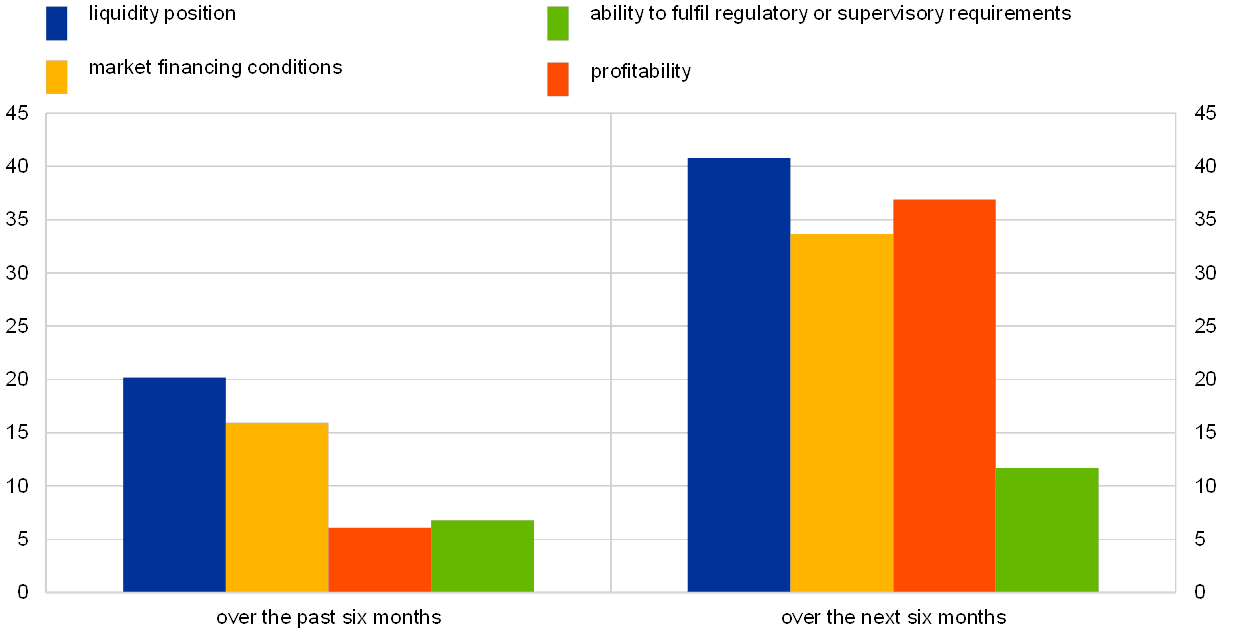
Notes: The signs for these net percentages have been inverted to show net improvements. Net percentages are defined as the difference between the sum of the percentages for “contributed considerably to a deterioration” and “contributed somewhat to a deterioration” and the sum of the percentages for “contributed somewhat to an improvement” and “contributed considerably to an improvement".
Banks reported that the TLTRO-III operations had a net easing impact on their terms and conditions (with a smaller impact on credit standards) and a positive net impact on lending volumes (see Chart 21). Banks reported a net easing impact on their terms and conditions for loans to enterprises and consumer credit over the past six months, while the impact on housing loans was broadly neutral (net percentages of ‑8% for loans to enterprises, -1% for housing loans and -5% for consumer credit), in line with the targeted nature of the TLTROs (excluding loans for house purchase). The net easing impact on credit standards over the past six months was limited to loans to enterprises and was only small (net percentage of -3%). In addition, banks reported a positive impact on their lending volumes for loans to enterprises (net percentage of 9%) and consumer credit (net percentage of 6%) over the past six months, whereas the impact on volumes of housing loans was neutral.
Chart 21
Impact of the TLTRO-III series on bank lending conditions and lending volumes
(net percentages of banks)
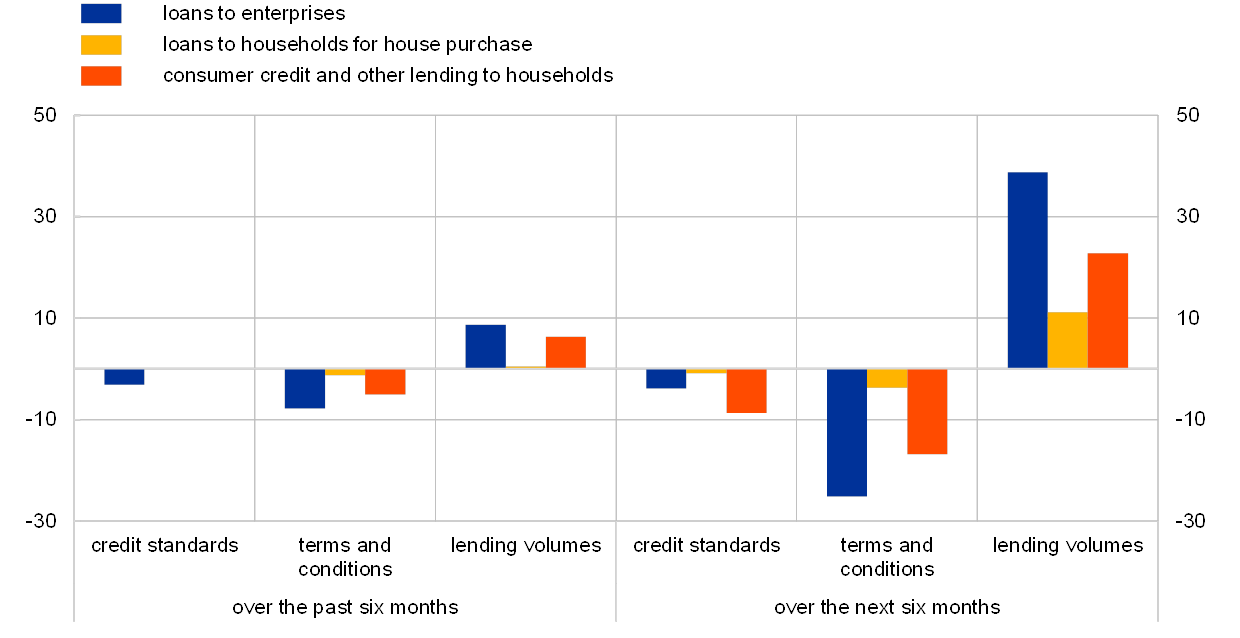
Notes: Net percentages are defined as the difference between the sum of the percentages for “contributed considerably to a tightening or decrease” and “contributed somewhat to a tightening or decrease” and the sum of the percentages for “contributed somewhat to an easing or increase” and “contributed considerably to an easing or increase".
Over the coming six months, banks expect a larger net easing impact on their bank lending conditions and a considerably more positive impact on their lending volumes. As regards credit standards, euro area banks expect a net easing impact for loans to enterprises (-4%) and for consumer credit (-9%) over the next six months, while the impact on housing loans is expected to remain broadly neutral. In addition, the net easing impact on terms and conditions is expected to become larger and include also housing loans (net percentages of -25% for loans to enterprises, -4% for housing loans and -17% for consumer credit). The positive impact on lending volumes is also expected to increase considerably (net percentages of 39% for loans to enterprises, 11% for housing loans and 23% for consumer credit).
Annexes
See more.
© European Central Bank, 2020
Postal address 60640 Frankfurt am Main, Germany
Telephone +49 69 1344 0
Website www.ecb.europa.eu
All rights reserved. Reproduction for educational and non-commercial purposes is permitted, provided that the source is acknowledged.
For specific terminology please refer to the ECB glossary.
PDF ISSN 1830-5989, QB-BA-20-001-EN-N
HTML ISSN 1830-5989, QB-BA-20-001-EN-Q
- The four largest euro area countries in terms of GDP are Germany, France, Italy and Spain.
- For more detailed information on the bank lending survey, see the article entitled “A bank lending survey for the euro area”, Monthly Bulletin, ECB, April 2003; Köhler-Ulbrich, P., Hempell, H. and Scopel, S., “The euro area bank lending survey”, Occasional Paper Series, No 179, ECB, 2016; and Burlon, L., Dimou, M., Drahonsky, A. and Köhler-Ulbrich, P., “What does the bank lending survey tell us about credit conditions for euro area firms?”, Economic Bulletin, Issue 8, ECB, December 2019.
- In this case, the selected sample banks are generally of similar size or their lending behaviour is typical of a larger group of banks.
- The non-harmonised historical data differ from the harmonised data mainly as a result of heterogeneous treatment of “NA” replies and specialised banks across questions and countries. Non‑harmonised historical BLS data are published for discontinued BLS questions and ad hoc questions.
- The calculation of a simple average when combining factors in broader categories assumes that all factors have the same importance for banks. This helps to explain some inconsistencies between developments in credit standards and developments in the main underlying factor categories in the relevant charts.
- The calculation of a simple average when combining factors in broader categories assumes that all factors have the same importance for banks. This helps to explain some inconsistencies between developments in demand for loans and developments in the main underlying factor categories.
- Considerable percentages of banks indicated that questions on securitisation were “not applicable”, as that source of funding was not relevant to them (between 42% and 55% of banks, depending on the type of securitisation).


